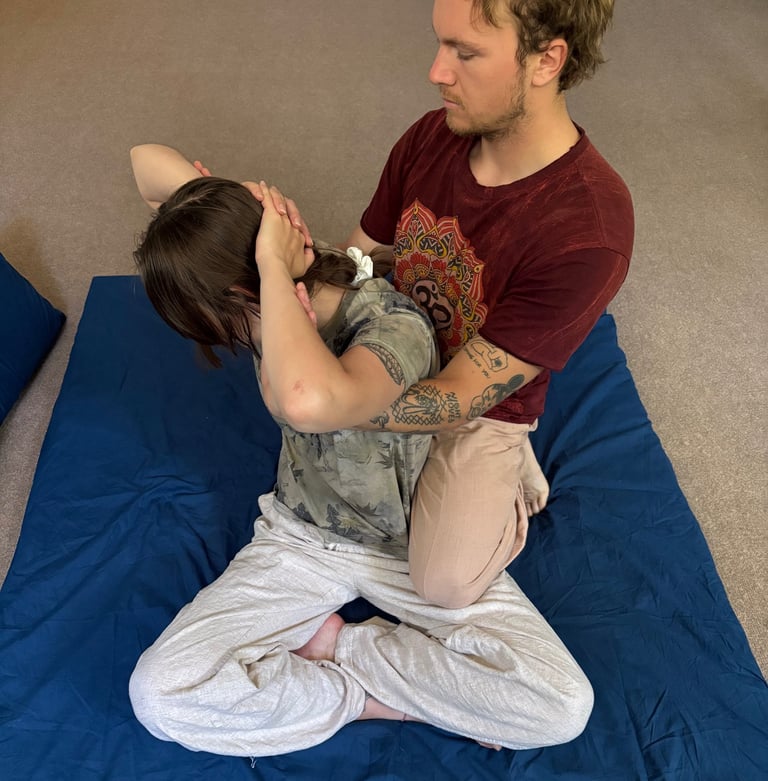Thai Massage Therapy
An ancient healing system combining acupressure, Indian Ayurvedic principles, and assisted yoga postures to create a comprehensive treatment that relaxes, energizes, and restores balance to the body, mind, and energy systems.


History & Origins
Thai massage, known in Thailand as "Nuad Boran" (ancient massage), has roots that date back over 2,500 years. It was developed in Thailand and influenced by traditional medicine systems from India, China, and Southeast Asia.
Traditionally attributed to Jivaka Kumar Bhaccha, a physician to Buddha, Thai massage was originally practiced in temples and was an integral part of Thai medicine, alongside herbal medicine, spiritual practice, and nutritional therapy.
The knowledge of Thai massage was preserved and transmitted orally and through practice from master to student. Today, the Wat Pho temple in Bangkok is considered the center for traditional Thai medicine and massage, where ancient teachings are preserved on stone inscriptions and manuscripts.
Key Elements of Thai Massage
Understanding the fundamental components that make Thai massage unique
Yoga-Like Stretches


Often called "lazy person's yoga," Thai massage incorporates passive stretching where the practitioner guides the recipient through yoga-like positions.
These assisted stretches help improve flexibility, release tension, and create space in the joints. The stretches range from gentle to more dynamic, always working within the recipient's comfort level and physical capabilities.
Sen Energy Lines


Thai massage works with the body's energy system through ten main "Sen" lines (similar to meridians in Chinese medicine). The practitioner uses rhythmic pressing and stretching techniques along these pathways to remove blockages and restore the free flow of energy.
When energy flows freely, the body can better heal itself and maintain optimal health. Each Sen line is associated with specific organs and body functions.


Accupressure Techniques
Rhythmic pressing along Sen lines and on specific points helps release blocked energy and stimulate the body's natural healing processes.
Unlike Swedish massage, which primarily uses kneading and friction, Thai massage uses palming and thumbing along energy lines and pressure points. This helps address specific health concerns and promotes overall wellbeing.


Mindful Awarness
Thai massage is performed with meditative awareness. The practitioner maintains focused attention and works with mindful, rhythmic movements.
This meditative quality creates a deeply relaxing experience for both the giver and receiver. The practitioner's centered presence helps facilitate the recipient's journey into deep relaxation and healing.
Benefits of Thai Massage
Experience the many ways Thai massage can improve your physical and mental wellbeing
Physical Benefits
Mental & Emotional Benefits
Therapeutic Applications
Increases flexibility and range of motion
Improves circulation and lymphatic flow
Relieves muscle tension and pain
Enhances athletic performance
Improves posture and alignment
Boosts energy levels
Strengthens the immune system
Reduces stress and anxiety
Promotes mental clarity
Improves mood & emotional balance
Deepens body awareness
Facilitates mindfulness
Enhances quality of sleep
Creates a sense of well-being
Relieves chronic back, neck, and joint pain
Addresses headaches and migraines
Helps with digestive disorders
Reduces symptoms of anxiety & depression
Improves respiratory conditions
Assists in recovery from injuries
Complements treatment for chronic conditions
What to expect in a session
Before Your Session
Wear comfortable, loose-fitting clothing that allows for movement. Unlike oil-based massages, Thai massage is performed fully clothed. Avoid heavy meals before your session, and arrive a few minutes early to complete any necessary paperwork and discuss your health history and goals.
During Your Session
You'll lie on a padded mat on the floor. The session begins with centering and gentle compression to prepare the body. The practitioner will use their hands, thumbs, elbows, knees, and feet to apply pressure along energy lines and guide you through stretches. The pressure and stretching intensity can be adjusted to your comfort level. A typical session lasts 90-120 minutes.
After Your Session
After the massage, take time to slowly transition back to your day. Drink plenty of water to help flush toxins released during the session. You may feel energized yet deeply relaxed. Some people experience mild soreness for 1-2 days, similar to after exercise. This is normal and indicates that the body is rebalancing and healing.




Ready to experience this ancient healing art for yourself? Book a Thai massage session and let's help you on your journey toward balance and wellness.






Contact
Get in touch for help with appointments and inquiries.
rileyclarklmt@gmail.com
503-427-8757
© 2025. All rights reserved.
Phone
Address
18862 SE Jacoby Rd, Sandy, OR 97055
LMT License #28742